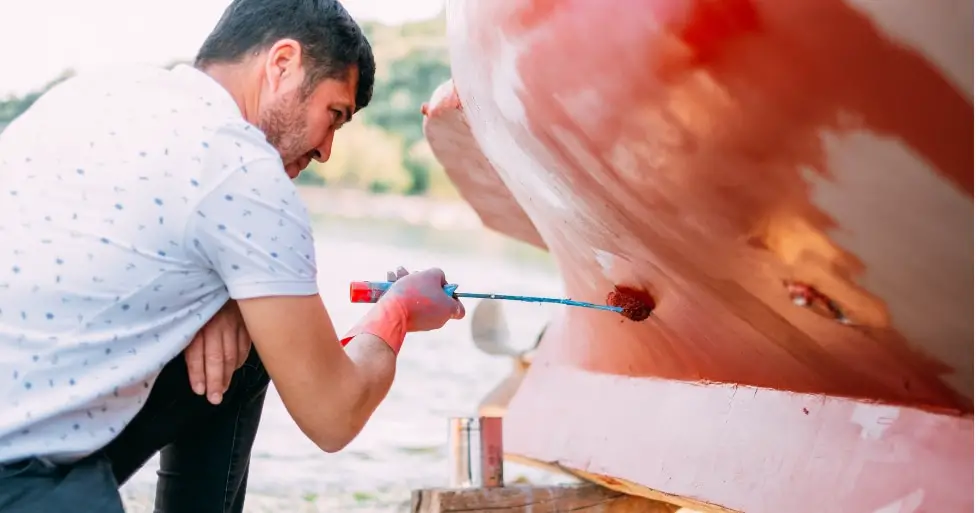Bottom paint (also known as anti-foiling paint) is paint you put on the bottom of your boat to slow the growth of marine organisms such as barnacles, slime, algae, and mossy weeds. It also acts as a corrosion deterrent for steel boats. (source)
Any boat that is kept in the water for over a month at a time should have anti-foiling bottom paint or an alternative such as Fab Dock to help prevent marine growth. Although these solutions are most needed for saltwater boats, freshwater boats may need them as well.
If you pull your boat out of the water often, you don’t have to worry about bottom paint because marine organisms will never have the chance to grow on your hull. Just make sure to wash and wax your boat often with high-quality products.
Difference between bottom paint and its alternatives
Bottom paint is just paint that you put on your hull. However, what many don’t talk about is how toxic bottom paint can be. Many governments are even starting to ban bottom paint. This is because all of the toxins, such as copper, that are in most bottom paints slowly seep into the water, hurting fish and other marine life.
A company called Fab Dock has found a solution to this. After you drive your boat into their intertube, their system will pump all of the water out, meaning your boat won’t fall victim to marine growth. I have no affiliation with Fab Dock, I just believe this is an amazing environmentally friendly solution.
Here’s what it looks like:

Factors to Consider When Choosing Bottom Paint
If Fab Dock is not for you, here are some factors to consider before purchasing bottom paint.
- Type of boat. Different types of boats have different bottom paint requirements based on the material of the hull, the type of use, and the type of water in which the boat will be used.
- Fresh or salt water. The type of bottom paint used should be suitable for the specific water conditions in which the boat will be used, such as saltwater, freshwater, or brackish water.
- Climate. The climate in which the boat will be used, including temperature and humidity, can impact the performance of bottom paint and may cause you to have to replace it more often.
- Personal preference. Some boaters may prefer bottom paint with specific properties, such as quick drying time, low odor, or low VOCs. It’s important to consider personal preferences when choosing bottom paint.
- Environmental effects. Bottom paint is known for not being very marine friendly by releasing toxins such as copper into the water. These toxins can harm fish and other marine life. So, it’s important to use brands that limit these harmful effects. Some governments may also restrict certain types of bottom paint.
What is the best bottom paint?
There are few good bottom paints out there, but here are my top picks for fiberglass, steel, wood, and aluminum boats:
Best for fiberglass, steel, and wood: TotalBoat JD Select
Not only does this antifouling bottom paint come in four different colors (black, blue, green, and red) it’s also known for being one of the best on the market. It is easy to apply, lasts a long time, keeps barnacles off, and it’s not too expensive, what else could you ask for?
Best for aluminum boats: TotalBoat AlumiPaint AF
Made by the same amazing brand as the bottom paint above, this paint is also one of the most popular on the market. It only comes in black and blue, but it will protect your aluminum from marine growth and corrosion. It also uses copper-free technology, so it’s less toxic to the environment.
How Often Should Bottom Paint be Applied to Boats?
You’ll want to re-apply anti-foiling bottom paint once every year or season; however, if you take your boat out of the water a few times each season, you may be able to get away with re-applying only every 2 years.
Depending on how big your hull is, and the type of bottom paint you use, expect it to cost around $100-$300 for every bottom paint re-apply. If you hire someone to do it, it could cost even more.
How to apply bottom paint on a boat
Painting bottom paint yourself can be a difficult process if you are not very familiar with painting. You’ll have to perform proper respiratory protection, sanding, taping, and properly applying enough paint layers throughout your hull. The video below shows exactly how to do it:
You can hire a professional to do this, but expect to pay $100-$300 more for labor costs.
- What Is The Cheapest Way To Store A Boat? - February 28, 2023
- Do Boats Need Bottom Paint? (Uncovering the Truth) - February 2, 2023
- How Much Is Bass Boat Insurance? (Real Quotes) - January 18, 2023



